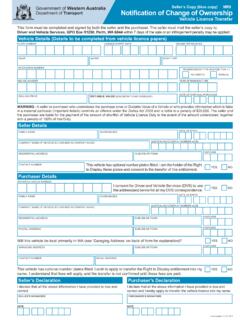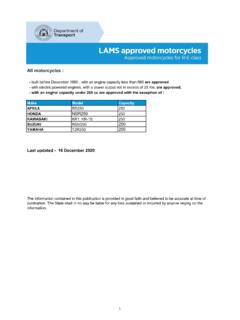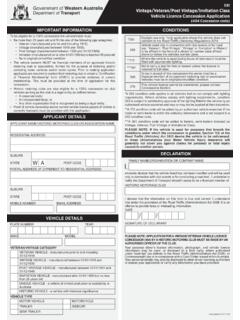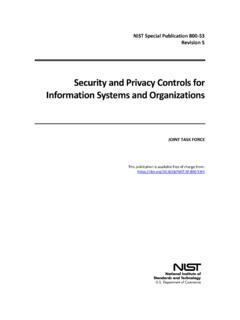Transcription of Sea Level Change in Western Australia - DOT Home
1 Sea Level Change in Western Australia Application to Coastal Planning Version Description Author Date 0 Final Report Charlie bicknell 2/02/2010. Department of Transport Coastal Infrastructure, Coastal Engineering Group TABLE OF CONTENTS. 1 State Coastal Planning Policy .. 1. Projecting Future Change .. 2. The Intergovernmental Panel on Climate Change (IPCC) .. 2. Commonwealth Scientific and Industrial Research Organisation (CSIRO).. 2. 2 HISTORICAL Global sea Level 3. Regional sea Level Change .. 5. Vertical land 6. 3 SHORT TERM CHANGES IN SEA 4 LONG TERM CHANGES IN SEA Level ..10. Emission 10. Global Projections for Sea Level 12. Regional Variations in Sea Level Projections .. 14. Recent comparisons of sea Level projections against records.
2 15. 5 SUMMARY & RECOMMENDATIONS ..17. TABLES. Table 1 - Estimated rates of historic global mean sea Level 3. Table 2 - Major processes influencing sea Level variability along the southwest WA coastline (Pattaratchi & Eliot, 2005).. 8. Table 3 - IPCC Description (IPCC, 2000) .. 10. FIGURES. Figure 1 - Reconstruction of global mean sea Level (GMSL) from tide gauge recordings 1870. to 2004. One (dark shading) and two (light shading) standard deviation error estimates shown.. 4. Figure 2 - Global mean sea Level from October 1992 from satellite 4. Figure 4 - Mean sea Level trends from satellite altimetry (Oct 1992 to Jul 2009).. 5. Figure 5 - Time series of annual mean tide gauge recordings at Fremantle with linear trend superimposed (red line).
3 5. Figure 5 - Location of tide gauges managed by 6. Figure 6 - Time series of monthly mean tide gauge recordings at Fremantle (solid line) and Hillarys (dashed line) with linear trends (1992 to 2008) superimposed (Fremantle , Hillarys mm/yr).. 7. Figure 7 - Fremantle average annual sea Level variation (1930 to 2008) .. 8. Figure 8 - Fremantle monthly mean water Level with sea Level rise and seasonal trends removed (dark blue) SOI Index scaled by 10 (light blue) .. 9. Sea Level Change in Western Australia Figure 9 - IPCC storyline and scenario families (IPCC, 2000).. 10. Figure 10 - Global carbon dioxide 11. Figure 11 - IPCC AR4 sea Level rise projections through the 21st century including scaled-up ice sheet discharge (dashed lines for 5th percentile and solid lines for 95th percentile) 12.
4 Figure 12 - Inertia in the climate system (Garnaut 2008 after IPCC 2001b: Figure ) .. 13. Figure 13 - Plausible upper bound estimates of sea Level rise .. 14. Figure 14 - Multi-model mean IPCC SRES scenario A1B projected sea Level departure from the global mean for 2070 (mm) .. 15. Figure 15 - Global mean sea Level , comparison of satellite recording against IPCC AR4. projections .. 16. Figure 16 - Recommended allowance for sea Level rise in coastal planning for WA (red line SRES scenario A1FI 95th percentile after Hunter (2009), normalised to 2010, blue line continuation of scenario to 2010) .. 19. LIST OF ABBREVIATIONS. ACE CRC Antarctic Climate and Ecosystems Corporative Research Centre CSIRO Commonwealth Scientific and Industrial Research Organisation CDIAC Carbon Dioxide Information Analysis Center DoT Department of Transport ENSO El Ni o southern oscillation IPCC Intergovernmental Panel on Climate Change IPCC AR4 Intergovernmental Panel on Climate Change Fourth Assessment Report IPCC TAR Intergovernmental Panel on Climate Change Third Assessment Report IPCC SRES Intergovernmental Panel on Climate Change Special Report on Emissions scenarios PSMSL Permanent Service for Mean Sea Level SOI Southern oscillation index SPP Statement of Planning Policy No.
5 : State Coastal Planning Policy UNEP United Nations Environment Programme WA Western Australia WBGU German Advisory Council on Global Change (Wissenschaftlicher Beirat der Bundesregierung Globale Umweltver nderungen). WMO World Meteorological Organization Sea Level Change in Western Australia 1 INTRODUCTION. This report has been prepared to review the current information on mean sea Level variation along the Western Australian (WA) coastline, and to provided recommendations on an appropriate allowance for mean sea Change to be used in coastal planning. It draws extensively from the existing work undertaken by the Intergovernmental Panel on Climate Change (IPCC), Commonwealth Scientific and Industrial Research Organisation (CSIRO), and the Antarctic Climate and Ecosystems Corporative Research Centre (ACE CRC).
6 In reading this report it should be understood that mean sea Level Change , although in many instances a dominant factor, is only one of the key environmental variables that may be effected by climate Change . These key environmental variables include: x mean sea Level ;. x ocean currents and temperature;. x wind climate;. x wave climate;. x rainfall / runoff; and x air temperature. The combined coastal impact of these variables will vary across the state and requires consideration on a local scale and case by case basis. This report focuses only on mean sea Level and does not consider the changes to extreme water levels which will occur as a result of the rise in mean sea Level and possibly through changes in storminess.
7 Further information on estimating extreme water levels can be gained from viewing the ACE CRC website State Coastal Planning Policy The WA Planning Commission Statement of Planning Policy No. : State Coastal Planning Policy provides guidance for the incorporation of mean sea Level Change in the determination of a coastal setback for new development. The policy is currently based on: x A 100-year planning time frame and ocean forces and coastal processes which have a statistical recurrence of once per one hundred years. x The mean of the median model of the latest Assessment Report of the IPCC. Working Group. At the time of gazettal (10 June 2003) this was the Third Assessment Report of the IPCC (January 2001), which corresponded to a sea Level rise prediction of m between 2000 and 2100.
8 The IPCC has now provided revised projections (IPCC AR4, 2007) for global mean sea Level and some additional work has also been undertaken by CSIRO to determine local variations around the Australian coastline. Sea Level Change in Western Australia 1. Projecting Future Change Estimating future changes in sea Level is a complex process. Our understanding of future projections is greatly improved by our review of historical Change and our assessment of natural variability. The basis of this approach is: 1. estimation of historical Change ;. 2. estimation of (short term) natural variability; and 3. projection of long term Change . The Intergovernmental Panel on Climate Change (IPCC). The IPCC is a scientific intergovernmental body set up by the World Meteorological Organization (WMO) and the United Nations Environment Programme (UNEP) in 1988.
9 The IPCC's mandate is as follows: The IPCC was established to provide the decision-makers and others interested in climate Change with an objective source of information about climate Change . The IPCC does not conduct any research nor does it monitor climate related data or parameters. Its role is to assess on a comprehensive, objective, open and transparent basis the latest scientific, technical and socio-economic literature produced worldwide relevant to the understanding of the risk of human-induced climate Change , its observed and projected impacts and options for adaptation and mitigation. IPCC reports should be neutral with respect to policy, although they need to deal objectively with policy relevant scientific, technical and socio economic factors.
10 They should be of high scientific and technical standards, and aim to reflect a range of views, expertise and wide geographical coverage. The Fourth Assessment Report (IPCC AR4) of the IPCC was published in early 2007 and consists of a number of volumes under the umbrella title Climate Change 20071. An assessment of historical sea Level Change and projections for future Change are contained within the Physical Science Basis, contributions of Working Group I to the Fourth Assessment Report. The work of the IPCC is focused on global climatic variations with some reference to regional variations. Commonwealth Scientific and Industrial Research Organisation (CSIRO). In 2007 the CSIRO released the technical report Climate Change in Australia2.










